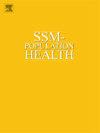COVID-19大流行期间增加远程医疗使用对药物使用障碍治疗的影响
IF 3.1
2区 医学
Q1 PUBLIC, ENVIRONMENTAL & OCCUPATIONAL HEALTH
引用次数: 0
摘要
背景:COVID-19大流行需要从面对面的物质使用障碍(SUD)治疗转向虚拟远程医疗(TH)就诊,从而为评估虚拟就诊对SUD治疗的影响创造了机会。方法本研究利用Oracle EHR真实世界数据中的回顾性、去识别、电子健康记录(EHR)数据来研究TH对SUD治疗的影响。纳入了来自141个美国卫生系统的合格SUD诊断患者,并将其分为th前(2017年1月1日至2019年1月1日)和COVID(2020年1月1日至2022年1月1日)队列。本研究分析了TH的使用情况、治疗SUD的药物处方、药物相关事件和心理健康危机,比较了治疗临床医生在COVID - 19前和COVID - 19期间高TH使用者和低TH使用者的患者结果。结果与低TH医生相比,高TH医生的患者MSUD处方率较低,但MSUD日供应量较高,门诊就诊率较高,两组患者在新冠肺炎期间的TH就诊均有所增加。与低TH提供者相比,高TH临床医生的患者与sud相关的住院率较低,但药物过量、复发、注射相关感染和精神健康危机的发生率相似。结论:这些模式显示出与sud相关的门诊就诊增加,但没有增加不良后果,表明其作为面对面护理的可持续替代方案的潜力。该研究强调需要进一步研究TH对SUD特异性人群的疗效,并支持在大流行后SUD治疗中继续整合远程医疗。本文章由计算机程序翻译,如有差异,请以英文原文为准。
The impact of increased telehealth use on the treatment of substance use disorder during the COVID-19 pandemic
Background
The COVID-19 pandemic necessitated a shift from in-person substance use disorder (SUD) treatment to virtual telehealth (TH) visits, creating opportunities to assess the impact of virtual visits on SUD treatment.
Methods
This study utilized retrospective, de-identified, electronic health record (EHR) data from Oracle EHR Real-World Data to examine the impact of TH on SUD treatment. Patients with a qualifying SUD diagnosis from 141 U.S. health systems were included and divided into pre-TH (January 1, 2017 through January 1, 2019) and COVID (January 1, 2020 through January 1, 2022) cohorts. This study analyzed TH utilization, medications for SUD (MSUD) prescribing, drug-related events, and mental health crises, comparing patient outcomes where the treating clinician was a high TH user versus a low TH user in both pre-COVID and COVID periods.
Results
Patients visiting high TH clinicians had lower MSUD prescribing rates, yet a higher MSUD day's supply, and higher rates of TH outpatient visits than those visiting low TH providers, with both groups having an increase in TH visits during the COVID period. Patients with high TH clinicians had lower rates of SUD-related hospitalizations than those with low TH providers but similar rates of drug overdoses, relapses, injection-related infections, and mental health crises.
Conclusions
TH modalities showed increased SUD-related outpatient visits without increasing adverse outcomes, indicating its potential as a sustainable alternative to in-person care. This study highlights the need for further research on TH efficacy for SUD-specific populations and supports the continued integration of telehealth in SUD treatment post-pandemic.
求助全文
通过发布文献求助,成功后即可免费获取论文全文。
去求助
来源期刊

Ssm-Population Health
PUBLIC, ENVIRONMENTAL & OCCUPATIONAL HEALTH-
CiteScore
6.50
自引率
2.10%
发文量
298
审稿时长
101 days
期刊介绍:
SSM - Population Health. The new online only, open access, peer reviewed journal in all areas relating Social Science research to population health. SSM - Population Health shares the same Editors-in Chief and general approach to manuscripts as its sister journal, Social Science & Medicine. The journal takes a broad approach to the field especially welcoming interdisciplinary papers from across the Social Sciences and allied areas. SSM - Population Health offers an alternative outlet for work which might not be considered, or is classed as ''out of scope'' elsewhere, and prioritizes fast peer review and publication to the benefit of authors and readers. The journal welcomes all types of paper from traditional primary research articles, replication studies, short communications, methodological studies, instrument validation, opinion pieces, literature reviews, etc. SSM - Population Health also offers the opportunity to publish special issues or sections to reflect current interest and research in topical or developing areas. The journal fully supports authors wanting to present their research in an innovative fashion though the use of multimedia formats.
 求助内容:
求助内容: 应助结果提醒方式:
应助结果提醒方式:


